Written by James Campbell - https://jamescampbell78.wordpress.com
The Lyke Wake Challenge has its origins in the Lyke Wake Race, which itself originates from the Lyke Wake Walk across the North Yorkshire Moors at their widest point from Osmotherley to Ravenscar. The history of which is here: https://en.wikipedia.org/wiki/Lyke_Wake_Walk
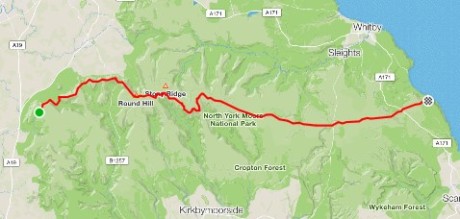
The Lyke Wake Route
The format of the Challenge is a handicapped staggered start based on estimated finish times provided by entrants based on previous Lyke Wake crossings or similar distanced races. I used a rough average of my paces from Hardmoors 55 and my Goathland Marathon races from 2015, mainly because Hardmoors 55 was my closest successful run of that sort of distance, covering some of the first half of the course and Goathland Marathon covered part of the second half. I gave my estimate at 11 hours and was appointed a start time of 5:20am.
There are prizes in the Challenge for fastest male and female crossings and the first male and female finishers to cross the line in Ravenscar.
Having raced and trained extensively on the stretch of the route between Osmotherley and Bloworth Crossing and led by Joe Williams, conducted a good recce of the second half of the route, I gave myself three aims.
- Finish inside of 11 hours.
- A stretch target of finishing in 10 hours.
- Since I was starting in the first 80 minutes of the appointed start times, a further stretch target of being in the first 10 finishers to reach Ravenscar.
The night before the race I slept in the car at Sheepwash, less than 100m from the start line at the Lyke Wake stone. A truly beautiful location, even if it was constantly busy from my arrival at 7pm all the way through the night with Lyke Wake walkers and other late night hikers.
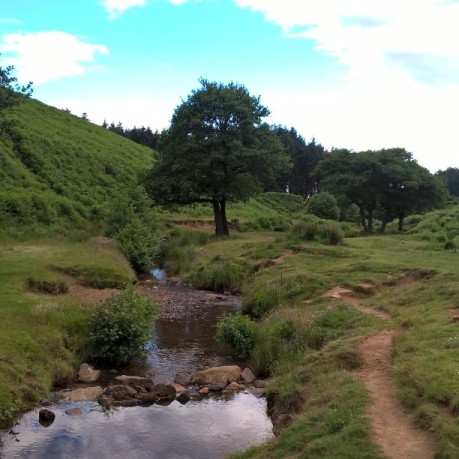
Sheepwash
After a restless nights sleep, my alarms went off at 3am and I began the process of getting a brew on and having a breakfast of porridge, cornflake tart made by Natalie (and had proved to be like rocket fuel on long training runs and rides) and strong coffee.
I went through my usual routine of packing food, drink and putting my kit on, for the first time in an ultra, I’d dispensed with the trisuit and went with standard shorts and compression shorts with my cycling jersey in anticipation of hot weather. The temperatures in the previous days had been 18-22 degrees and even though rain was forecast (and arrived on cue just after 3am), I still expected it to be warm.
At 4am I had a wander to the start line to find race directors Anthony Corbett, Roy MacDougall and their team setting their tent up. Having said hi and disposed of my previous night’s rubbish, I retreated back to the car for a drink of Lucozade Sport and to put my trail shoes on. I returned to the start to watch the first runners away at 4:20am and get signed on. The rain stopped and the flying, biting insects appeared so I scrounged some repellant from Anthony in the hope of avoiding being bitten.
I hung around and watched Michelle Boshier and Emily Beaumont set off at 5am as the anticipation and nerves built up ahead of my own start. I returned to the car and made sure it was properly locked before returning to the start to toe the line with fellow 5:20am runners Lorna Simpkin and Russ Kelly.
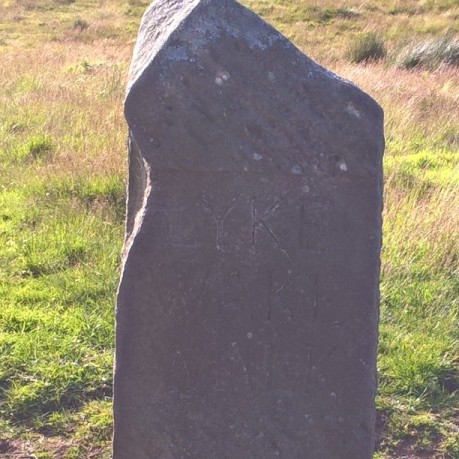
The Lyke Wake post at Sheepwash
We set off under the overcast skies running steady and chatting away. I was pleased to note that on the first small climb towards Scarth Nick, the legs felt wide awake and strong. I ran along chatting with Lorna and Russ until I slowly began to pull away from them just before the steep steps in the woods on the Cleveland Way. At this point I was running off feel and felt comfortable, so wasn’t worried about running faster than the other two and just went with the flow, put my earphones in to listen to some music and cracked on. However, at just over 4km into the run, with around half an hour gone, my right heel started giving the ominous first signs of a blister. I was pretty pissed off with this because I’d used Asda blister plasters to pre-treat my heels and protect them from this and stubbornness made me persevere up the steep steps onto Live Moor and onwards towards Carlton Bank before I accepted that the pain was getting worse and if I I didn’t deal with the blister it was going to cause me major issues up the road.
I pulled off my pack to find a plaster while walking an uphill section, noting that I could see Michelle and Emily cresting the top of Carlton Bank at the Trig point about 500m in front of me and could see Lorna and Russ equidistant behind me. The plaster I pulled out was a 6 inch long strip of old fashioned über sticky fabric plaster that usually requires extra sharp scissors to cut. I decided that this stuff would probably last the day and ran along rubbing it between my hands to warm the sticky stuff up, intending to deal with the blisters at the checkpoint on Raisdale Road, however the pain was so bad that I stopped at the Trig point and stripped off my shoe, gaiter, calf guard and sock and dealt with an already awful blister with the huge overkill strip of plaster.
I’d just got my footwear back on when I was caught by Lorna and Russ and we headed down the steep steps, I immediately felt a lot more comfortable and descended quickly jogging into the first checkpoint at 6:37am (1h:17m) almost bang on my planned pace. I stopped to re-tie my left shoe and was quickly away through Lord Stones country park passing Michelle and Emily then a group of early morning walkers.
Rather than go over the brutal steep climbs of the tops of Cringle Moor, Cold Moor and Hasty Bank, which were all shrouded in mist, I opted, like many others to take the low path around the Three Sisters which was often muddy, but not as hard on the legs. I think it was a good choice as the trees protected me from the breeze that was picking up and the path was a lot dryer than in usually was, even so I had gone ankle deep in mud several times before arriving at the Clay Bank checkpoint at 7:22am (2h:02m), again pacing almost exactly on plan. I stopped to get my number clipped, grab a jaffa cake and smiled at the photographer before heading over the road and up the really steep climb towards the highest point of the moors, Urra Moor.
The climb was fairly relentless but I cracked on at a constant pace, occasionally thinking that I could just make out a dayglow rain jacket ahead in the distance, but the mist was closing in and made it hard to tell. Looking back a km or so down the hill, I couldn’t see anyone behind me and thought that those following must have taken the higher path, which I knew could add up to 20 minutes onto your time.
I was soon past the Trig point to the left of the path at Round Hill and began to pick up pace running on the wide sandy track towards Bloworth Crossing, already ticking off 17.5km in 2h:35m and starting to realise that my legs were in the mood to really play ball.
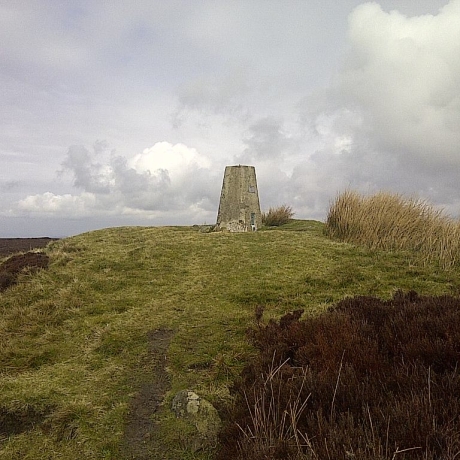
The Trig at Round Hill in much clearer weather
I made it to Bloworth Crossing and checked time at 2h:50m. As I guzzled the last of the Lucozade in the soft flask in my back pocket, I could see that the old Farndale Railway track ahead was covered by thick fog and there would be little to look at to keep my mind occupied, having recce’d this section in thick fog, I knew that would make it mentally tough and difficult to gauge progress. Since I was starting on an even 10 mins, I decided to run some intervals to keep my mind occupied. I settled into a pattern of 5 minutes running and 1 minute walking. After 3 intervals I had a 2 minute walk break and had some food before cracking on again. Just ahead I could make 2 human shapes in the distance and slowly began to reel them in while maintaining my pattern.
I passed them both at the end of a run interval and found they jogged past me again while I was walking. I got going again and passed and found that one of the pair had followed and jogged on with me. We chatted a few minutes going through a run and walk interval together, then he dropped away during my next run. During my next walk interval, I realised that I wasn’t far from the Blakey Ridge turn and decided to see if I could run all the way there. I was about halfway through this longer 1.3km interval when I saw another runner ahead. He looked over his shoulder then picked up pace. I decided I wasn’t that bothered about chasing anyone down and in any event he had probably started around an hour before me, so based on the ground I’d made already, I’d eventually catch him at some point. As the route turned left off the old railway track and up the hill towards the Lion Inn I was only a few metres behind and I thought I heard him say something. I pulled out my earphone and he told me that if I passed him, I would be in the lead. I followed him up the hill to the next checkpoint, where we arrived together at 9:08am (3h:48m).
Since I was now out of both Lucozade and water, I got my soft flask and 1 UD water bottle filled with water and the other filled with cola while I wolfed down some very welcome rice pudding. I jogged out of the checkpoint now in the lead and I was shouted back by Phil Rutter to take a photograph before I headed away along the fogbound road.
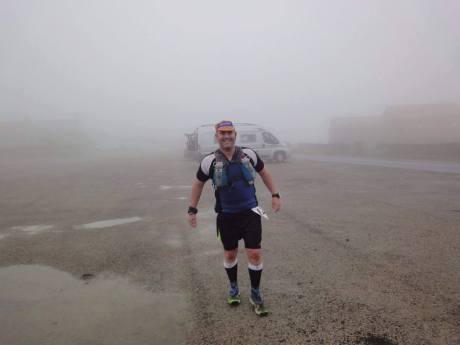
Lion Inn Checkpoint at Blakey Ridge
As I jogged along the road, passing groups of walkers, I began to consider the fact that I was now leading the race. I’d previously not been bothered about race position beyond thinking that it would be nice to be in the first 10 finishers, but now out in front, I wondered whether I should try and stay there or accept the inevitable fact that the faster runners behind me were going to eventually chase me down.
As I cut across Rosedale Head and came back to the road by Fat Betty, I couldn’t make out anyone behind me in the fog and thought to myself, “It’s only another 22 miles, not that far really. If I really, really try I could push myself into a good position and maybe they won’t catch me.”
Having never, ever led a race before I started to think what the best way to go about defending a lead was. At this point my mind was kind of hoping for some wise advice, but instead of an Obi Wan Kenobi-like voice in my head, a voice from my youth appeared in the form of Alex Stone offering the simple directive, “Simple Jim, just run like stink!”. In the absence of anything better, that’s what I did. I lifted up my head and picked up the pace along the road before turning hard left into what is commonly known as “the boggy bit” of the course.
The boggy bit starts with a single track, then widens and the ground starts to feel nice and bouncy underfoot as you head into the peat, soon , you start to hear the squelching underfoot, then the slurping as you sink in a bit. On the recce, with Joe Williams, he pointed out the line of white topped standing stones that marked the route through the marsh and it’s waist high grass. In the fog, these weren’t visible and there hadn’t been a lot of walker through ahead of me to beat down the long grass into a visible path.
I decided to simply plough on straight ahead and hope for the best, mostly this worked and I only had to divert a couple of times when I came to patches of obviously deep standing water. The only way the next few miles could have been more of a Quagmire was if it was uttering “Giggidy Giggidy” as I passed. The mud varied from ankle deep to knee deep from metre to metre, but I just pushed on.
I soon arrived at the Hamer checkpoint, bang on 10:35am (5h:15m) and was directed into the tent by Anthony Corbett (who I saw at every CP apart from Jugger Howe) for a random kit check while I got my cola bottle refilled. I was soon back on my way, heading along another section of bog and rocky trail towards Blue Man I’ Th’ Moss, an ancient standing stone. It has now started to rain quite heavily and water was running freely along the path soaking the peat as I scrambled across ditch after ditch on the way to the ancient stone. At one point I was stood on a ledge that just gave way below me leaving my right foot up high and the left side of my body dropping down half a metre, jarring my ankle. As I got going over the next summit, the soreness of the ankle prompted me to pop a couple of paracetamol.

Blue Man I’ Th’ Moss
I was now heading downhill past woodland towards Wheeldale and the path was now a series of slippy rocks surrounded by puddles. Given that my feet were soaked, I wasn’t bothered where they landed as long as the ground was stable and I picked up pace again. As I moved on, I dropped below the fog layer and the sun came out. For the first time all day, I had clear line of sight for over a mile behind me and I couldn’t see anyone following me. Encouraged by this, I picked up pace again and pushed hard into the Stape checkpoimt arriving 11:36am (6h:16m) and was quickly through and bounding down the almost vertical descent to Wheeldale Beck. As I reached the bottom, I took advantage of the long grass to relieve myself, which in turn indicated to me that I wasn’t drinking enough. I had a full soft flask of water in my back pocket and half a bottle of coke up front left, plus another half bottle of water which I’d mainly been using to squirt over myself to keep cool. I dipped my cap and buff in the beck and gave my body a rub over with the water before heading up the steep hill toward Simon Howe. Looking back up to the checkpoint, I still couldn’t see anyone following me, but my legs were feeling good and I didn’t fancy leaving much to chance so I headed up the hill running intervals to my music, running for one song, resting for another until I hit the top of the hill.
On the way down, I finished the cola and topped the UD bottle up with the water from the soft flask and decided to add some Etixx energy drink powder to the bottle. It tasted like liquid sherbet but was definitely giving me a bit of a kick as I thundered my way down the long downhill stretch into Ellerbeck, where the best checkpoint ever awaited (arrival at 12:35pm, 7h:15m). On the table was a wide range of food, but I only had eyes for two items, freshly cooked sausgage and huge chunks of watermelon. I scoffed a sausage, topped my water bottle up and took a chunk of watermelon to eat as I ran towards what I reckoned to be the hardest section of the day, the boggy, 4km climb from the A169 to the Cross at Lilla Howe. Having jumped across Eller Beck, I decided on more paracetamol to get me through the final stretch and found that I’d dropped my stash somewhere. I decided that I wasn’t bothered and cracked on.
It was simply impossible to do anything ather than fast walk the marshy section of the climb, but I knew there was a section of MOD road coming up and forced myself to run that entire stretch when I hit it. I stopped at the top of Lilla Howe and looked back 4km along the trail to the last checkpoint and still couldn’t see anyone following. I now only had 10km to go and had at least a 4km lead. I’d already mentioned to Anthony at Ellerbeck that I felt like one of those unknown riders who somehow gets away up the road on a Tour de France stage and was wondering whether the big hitters would even know I was out there or be able to catch me if they did. I made up my mind that if I got to Jugger Howe without being caught, I’d run all the way to the finish.
I made use of the descent away from Lilla Howe picking up pace again but as the path became more rocky I turned the ankle I’d already knocked again and eased right off and had a couple of minutes walk break to stretch the ankle out gently. I realised the sun was quite warm and tipped a good load of water over my body again and as I turned round to look back along the trail before running again, I saw a red T-shirt on the horizon.
I looked at my watch, I’d done 56km, I was 8km from Ravenscar, swore loudly and took off like a scalded cat. I was amazed that I’d gone from not being too bothered about going for first place at Blakey, to now being so bloody minded that I was prepared to blow my legs just to make this guy work hard to catch me. I blasted along at 5m:20s/km for a bit, occasionally looking back and seeing him gaining fast. After about a km I was knackered and slowed up and I was caught, the runner coming past, Paul Havis, was going at around 5m/km as he passed, we exchanged words and he was gone, quickly descending the steps into the Jugger Howe ravine. I was halfway down when he was cresting the steps at the other side. Now paranoid that I’d be caught by a series of runners, I pushed hard up the other side of the ravine and up the long uphill drag to the next checkpoint to find that Paul had already made 7 minutes on me as I arrived at 2:04pm (8h:44m).
I had a seemingly endless wait to cross the main Whitby Road and as soon as I was across I pushed on as hard as my legs would allow. At the start of the day, I’d have been over the moon with a 10 hour finish, but now I had the realistic chance of finishing before 3pm, somewhere close to 9 hours and as second finisher if I could just make sure that nobody else caught me. The drag to the radio mast at Ravenscar seemed to take forever, but I knew, that once I was past it, it was all downhill. I crossed the road past the mast and cut along the path behind it to the steep downhill footpath across the field, bouncing along, battering the blisters on my toes and not caring. I was soon on the road and pushing out 6m/km, increasing to 5m:30s/km as I turned the corner down the final stretch to Raven Hall, pushing faster to 5m/km as I got closer to the gate and turned into the finishing funnel at a furious sprint finish to cross the line at 2:40pm clocking 9h:20m for a run of 64.4km containing 1,429m of ascent and some of the most difficult terrain I’ve run on.
I was met at the end (as was every runner) by Anthony Corbett whose team from Quakers Running Club had put on an astonishingly well organised event.
I laid at the finish line until 5pm watching runners come home to a fantastic atmosphere.
The eventual prize winners of the day were:
First Male Home: Paul Havis at 2:27pm
First Female Home: Vicky Howe at 3:41pm
Fastest Male: Ben Hamilton in 6h:06m
Fastest Female: Shelli Gordon in 6h:58m
These were superb performances on a very tough course in warm, humid conditions. Everyone who ran that course deserves massive respect, a friend of mine told me beforehand that the route was “A trial by combat” and he was not wrong.
Personally, I’m over the moon with my own performance. Some of it is down to the rewards of losing over a stone in weight and getting a lot more time on my feet in over the last month or so, but a lot of it was down to forcing myself to push harder instead of plodding, just aiming to finish the course in what I thought I could finish it in. In pushing hard, I’ve learned that I can go faster, for longer without burning out and even if I want to can force a really hard pace after hours on the road, as my burst to try and avoid being caught and my sprint finish proved. As the old saying goes, ultrarunning is 90% mental and 10% MENTAL.
